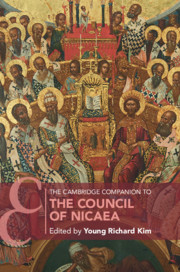Book contents
- The Cambridge Companion to the Council of Nicaea
- Cambridge Companions to Religion
- The Cambridge Companion to the Council of Nicaea
- Copyright page
- Dedication
- Contents
- Figures
- Contributors
- Acknowledgements
- Abbreviations
- 1 Introduction
- Part I Contexts
- Part II The Council
- Part III Outcomes
- Part IV The Aftermath
- 11 The Reception of Nicaea and Homoousios to 360
- 12 The Emergence of the Pro-Nicene Alliance
- 13 Apollinarius and the Nicene Homoousion
- 14 The Council of Ariminum (359) and the Rise of the Neo-Nicenes
- Part V The Long Reception
- Appendices
- Bibliography
- Index
- References
14 - The Council of Ariminum (359) and the Rise of the Neo-Nicenes
from Part IV - The Aftermath
Published online by Cambridge University Press: 17 December 2020
- The Cambridge Companion to the Council of Nicaea
- Cambridge Companions to Religion
- The Cambridge Companion to the Council of Nicaea
- Copyright page
- Dedication
- Contents
- Figures
- Contributors
- Acknowledgements
- Abbreviations
- 1 Introduction
- Part I Contexts
- Part II The Council
- Part III Outcomes
- Part IV The Aftermath
- 11 The Reception of Nicaea and Homoousios to 360
- 12 The Emergence of the Pro-Nicene Alliance
- 13 Apollinarius and the Nicene Homoousion
- 14 The Council of Ariminum (359) and the Rise of the Neo-Nicenes
- Part V The Long Reception
- Appendices
- Bibliography
- Index
- References
Summary
It was not until the aftermath of the Council of Ariminum (359) and its Constantinopolitan confirmation (360), which officially professed a Homoian creed, that a pro-Nicene reaction took shape and galvanized the West. In the decades that followed a series of Latin bishops wrote apologetic-like discourses, defending the Nicene faith (against the authority of Ariminum) by providing renewed interpretations of the Nicene Creed and the relations of the Father, the Son, and the Holy Spirit. Following in the tracks of Hilary of Poitiers and Marius Victorinus, a small handful of writers such Gregory of Elvira, Ambrose of Milan, Zeno of Verona, and Augustine gradually carved out a pro-Nicene doctrine of the Trinity and adjoining biblical hermeneutics that had completely rid itself of Photinian elements. By the Council of Aquileia (381), neo-Nicenes formed a hegemony, but one which did not dominate the theological and political landscape until the mid-380s.
Keywords
- Type
- Chapter
- Information
- The Cambridge Companion to the Council of Nicaea , pp. 305 - 324Publisher: Cambridge University PressPrint publication year: 2021



